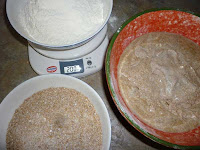Rye With Spelt, Whole Wheat with All Purpose Sourdough Loaves
These loaves were tossed together so I would have bread to eat. Mostly I was using up some old sourdough starter that I should have discarded a while back. It had been refrigerated, but it was old old old .
The rye sourdough was at 75% hydration; the whole wheat sourdough was at who knows what hydration. I had mixed it up by mistake a long time ago, adding far too much water when I was refreshing my sourdough, and setting it aside rather than trying to fix it. Now when I looked inside, there was a thick inch and a half of black hooch on top, which I now just poured away. The whole wheat had settled, and it was still quite wet. I wasn't able to use the recipe as-is, so I had to add a bit of all purpose flour to make it seem like real dough.
The recipe I have used before; the first time I made it was in August; I've made it several times since then, for example here, there, again, and again, and yet again; the original recipe was from a CIA Sourdough Rye Bread. I also use the same ratios for a sourdough wheat bread, too.
- Starter: 92.7%
- Flour: 100%
- Yeast: 0.8%
- Water: 85.4%
- Salt 2%
The Rye:
In the beginning
When it rises, it certainly expands.
The Whole Wheat:
Before rising
After rising
Normally this would have proofed in the tin only 30-40 minutes; but I kept the dough in there before baking for about 2 hours before I preheated the oven. When the oven was hot, I docked the loaves, painted them with yogurt and then sprinkled sesame seeds on top.
The loaves were beginning to smoke; when I finally removed them from the oven 65 minutes later,
Things I did differently this loaf:
- I tossed the salt on the countertop, and then kneaded the loaf until all was incorporated into the dough.
- I put olive oil in the rye tin; but I put olive oil and then cornmeal in the whole wheat tin.
- I carefully docked both loaves.
Can't really say I learned all that much from these loaves. Perhaps: don't line your tins with nothing but olive oil. The rye loaf turned quite dark and smells like acrylamides.
Despite the overbaked crust in areas, these loaves are very nice inside, and they taste marvelous (to me). I had some for breakfast, and was impressed with the way the whole wheat resembled a sandwich bread, and the rye even stood up to further toasting. I had them with a bit of nippy cheese and the bread was mild but full bodied. I'm happy with these loaves, even if I do have to remove some of the charred crust from the short end.
Notes to Myself
- Do not have so much oil in the pan that the loaf will boil in it; better to dust the oil with some flour or cornmeal or something, to prevent this.
- Would scoring the rye loaf have been better than docking it? The crust is popping like popcorn, and a more controlled expansion might be nice. But this no-knead technique does not align the gluten, so how do you know how to score it?




























No comments:
Post a Comment